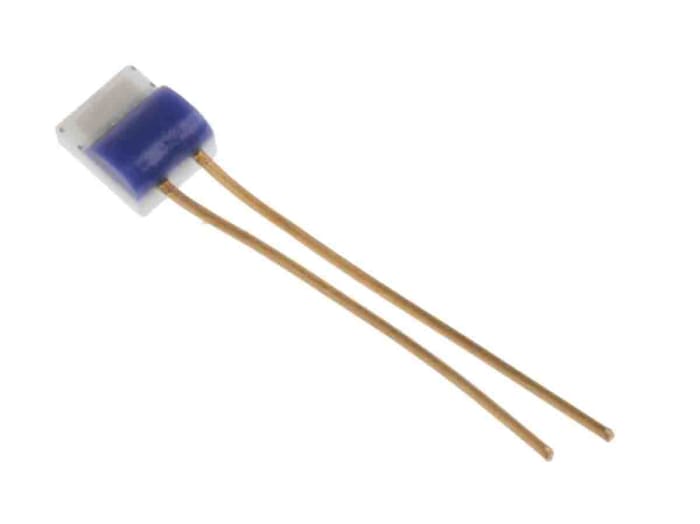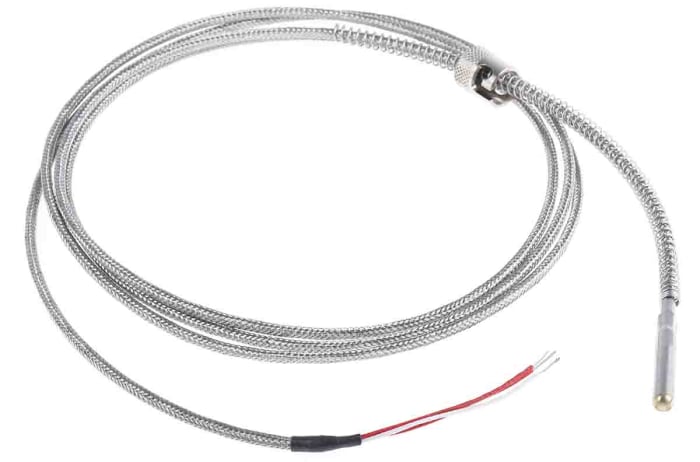Technical documents
Specifications
Brand
RS ProSensor Type
PT100
Probe Length
35mm
Probe Diameter
6mm
Minimum Temperature Sensed
-50°C
Maximum Temperature Sensed
+250°C
Termination Type
Bare Wire Tail
Cable Length
1m
Probe Material
Stainless Steel
Process Connection
Probe
Number Of Wires
2
Accuracy
Class B
Distrelec Product Id
30425530
Country of Origin
United Kingdom
Product details
RS Pro 2 Wire Pt100 PRT Stainless Steel Sheathed Sensor
From RS Pro a high-quality and reliable Pt100 PRT (Platinum Resistance Thermometer) or RTD (Resistance Temperature Detector). This Pt100 RTD has a sensing element that is encased in a flat stainless steel sheath so it can be used to measure the temperatures on surfaces. The twin twisted leads are insulated with durable and flexible Teflon. This platinum resistance thermometer provides accurate and reliable temperature measurement for a wide range of applications.
What is an RTD
An RTD is a type of temperature sensor based on the correlation between metals and temperature. As the temperature of a metal increases so does its resistance to the flow of electricity. This resistance can be measured and converted to a temperature reading. In a Pt100 RTD, the ’Pt’ stands for platinum (platinum wire or film) and ’100’ means that the temperature sensor has a resistance of 100 Ohms at 0°C. Platinum is the most reliable metal due to its linear resistance to temperature relationship over a large temperature range.
What is a Pt100 Stainless Steel Sheathed Sensor?
A Pt100 stainless steel sheathed sensor is designed to measure the temperature on surfaces. The temperature sensor element is embedded inside a stainless steel sheath with a flat sensing surface which is attached to the application surface. The other end of the sensor is terminated by 2 wire tails which are connected to the temperature measuring equipment.
Features and Benefits
• High stability sensing element with a precision output
• IEC 60751 Class B accuracy/tolerance, the expected tolerance of integral PT100 with conductor is E = (0.75 +0.005*l t l)⁰C ( l t l is the absolute value of the temperature. For example, when t = 0, E = 0.75⁰C, when t=100, E=1.25⁰C.)
• Flat stainless steel sheath for sensor element protection and measuring surface temperatures
• Temperature measurement range of -50 to +250°C
• Teflon insulated leads for thermal and electrical insulation, impact strength and protection against moisture, corrosion and abrasive chemicals even in extreme temperatures
Applications
These stainless steel sheathed PRT surface sensors with their compact and versatile design are suitable for use in a wide range of applications including:
• Air conditioning and refrigeration
• Chemical industry
• Plastics processing
• Stoves and grills
• Air, gas and liquid temperature measurement
• Exhaust gas temperature measurement
• Food processing
• Laboratories
Frequently Asked Questions
How Does a PRT Temperature Sensor Work
The PRT temperature sensor works by placing the sensor element (or process end) into the equipment or process that requires temperature measurement. As the temperature of the platinum resistance thermometer increases it’s resistance to the flow of electricity increases. For every increase per degree of temperature the electrical resistance also changes by a set ratio, this is called the temperature coefficient. For platinum, this ratio is .00385 ohm/ohm/°C which means for a Pt100 with a 100 ohm resistance the increase in resistance per degree of temperature would be 0.385 ohms. The total resistance reading can, therefore, be measured and converted into temperature.
How is the Resistance Measured?
The resistance generated by the temperature sensor is measured by passing current through one of the wires to produce a voltage. This voltage is then measured using a suitable bridge or voltmeter and the resistance calculated in ohms using Ohm’s Law (R=V/I). Once the resistance is known you can convert it to a temperature reading using a calibration equation or a Pt100 table. A temperature measurement device or calibrator can also be connected to the leads of the probe that will automatically convert the measured resistance into a temperature reading.
P.O.A.
1
P.O.A.
Stock information temporarily unavailable.
1
Stock information temporarily unavailable.
| quantity | Unit price |
|---|---|
| 1 - 14 | P.O.A. |
| 15 - 24 | P.O.A. |
| 25+ | P.O.A. |
Technical documents
Specifications
Brand
RS ProSensor Type
PT100
Probe Length
35mm
Probe Diameter
6mm
Minimum Temperature Sensed
-50°C
Maximum Temperature Sensed
+250°C
Termination Type
Bare Wire Tail
Cable Length
1m
Probe Material
Stainless Steel
Process Connection
Probe
Number Of Wires
2
Accuracy
Class B
Distrelec Product Id
30425530
Country of Origin
United Kingdom
Product details
RS Pro 2 Wire Pt100 PRT Stainless Steel Sheathed Sensor
From RS Pro a high-quality and reliable Pt100 PRT (Platinum Resistance Thermometer) or RTD (Resistance Temperature Detector). This Pt100 RTD has a sensing element that is encased in a flat stainless steel sheath so it can be used to measure the temperatures on surfaces. The twin twisted leads are insulated with durable and flexible Teflon. This platinum resistance thermometer provides accurate and reliable temperature measurement for a wide range of applications.
What is an RTD
An RTD is a type of temperature sensor based on the correlation between metals and temperature. As the temperature of a metal increases so does its resistance to the flow of electricity. This resistance can be measured and converted to a temperature reading. In a Pt100 RTD, the ’Pt’ stands for platinum (platinum wire or film) and ’100’ means that the temperature sensor has a resistance of 100 Ohms at 0°C. Platinum is the most reliable metal due to its linear resistance to temperature relationship over a large temperature range.
What is a Pt100 Stainless Steel Sheathed Sensor?
A Pt100 stainless steel sheathed sensor is designed to measure the temperature on surfaces. The temperature sensor element is embedded inside a stainless steel sheath with a flat sensing surface which is attached to the application surface. The other end of the sensor is terminated by 2 wire tails which are connected to the temperature measuring equipment.
Features and Benefits
• High stability sensing element with a precision output
• IEC 60751 Class B accuracy/tolerance, the expected tolerance of integral PT100 with conductor is E = (0.75 +0.005*l t l)⁰C ( l t l is the absolute value of the temperature. For example, when t = 0, E = 0.75⁰C, when t=100, E=1.25⁰C.)
• Flat stainless steel sheath for sensor element protection and measuring surface temperatures
• Temperature measurement range of -50 to +250°C
• Teflon insulated leads for thermal and electrical insulation, impact strength and protection against moisture, corrosion and abrasive chemicals even in extreme temperatures
Applications
These stainless steel sheathed PRT surface sensors with their compact and versatile design are suitable for use in a wide range of applications including:
• Air conditioning and refrigeration
• Chemical industry
• Plastics processing
• Stoves and grills
• Air, gas and liquid temperature measurement
• Exhaust gas temperature measurement
• Food processing
• Laboratories
Frequently Asked Questions
How Does a PRT Temperature Sensor Work
The PRT temperature sensor works by placing the sensor element (or process end) into the equipment or process that requires temperature measurement. As the temperature of the platinum resistance thermometer increases it’s resistance to the flow of electricity increases. For every increase per degree of temperature the electrical resistance also changes by a set ratio, this is called the temperature coefficient. For platinum, this ratio is .00385 ohm/ohm/°C which means for a Pt100 with a 100 ohm resistance the increase in resistance per degree of temperature would be 0.385 ohms. The total resistance reading can, therefore, be measured and converted into temperature.
How is the Resistance Measured?
The resistance generated by the temperature sensor is measured by passing current through one of the wires to produce a voltage. This voltage is then measured using a suitable bridge or voltmeter and the resistance calculated in ohms using Ohm’s Law (R=V/I). Once the resistance is known you can convert it to a temperature reading using a calibration equation or a Pt100 table. A temperature measurement device or calibrator can also be connected to the leads of the probe that will automatically convert the measured resistance into a temperature reading.


